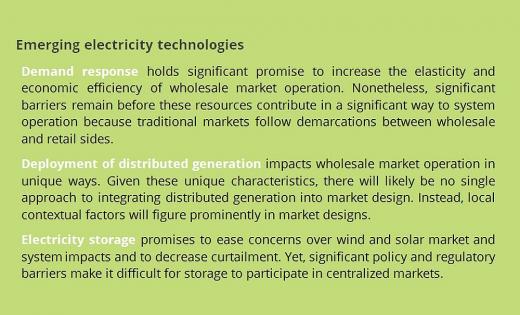Issues:
Sectors:
Keywords:
1. Introduction – A sustainable market design
A sustainable market design needs to form the framework for realizing long-term objectives and has to withstand short and medium-term changes. It further needs to ensure a guaranteed and reliable supply of electricity and has to enable the efficient use of resources and provide simultaneously innovation and investment incentives1.
Across the globe, electricity delivery is mainly organized in one of three different ways2:
- In some regions utilities operate under the traditional vertically integrated utility model. In these regions, a single entity owes and operates most or all assets, and costs are recovered through a regulated rate of return. Capacity mechanisms fall broadly into one of two categories.
- In the first the regulator sets a price for generation capacity and lets the market determine the amount of available capacity.
- In the second the regulator sets the amount of capacity that must be available and then allows the market to determine the price.
- In other regions, the generation, transmission, and distribution of electricity are unbundled. While the transmission network usually remains regulated, the generation activities are opened to competition. Energy is then transacted in a wholesale power market. Long-term adequacy is addressed through the so-called "energy-only" markets.
- The third way to organize electricity delivery mainly builds up as the second, but there is an additional revenue mechanism to reward generators for their availability, regardless of actual generation. These are the so-called "energy plus capacity" markets2.
In many rapidly developing economies, policy debates concentrate on whether and how to move from the vertically-integrated standard to the "energy-only" or "energy plus capacity" in order to better meet rapidly growing demand, improve reliability, achieve better economic efficiency, and accelerate the integration of variable renewable energy2. Policy debates in Europe, however, currently focus on whether to expand the markets to include the "energy plus capacity" idea.
At the same time, new opportunities for addressing the variability of renewables are being strengthened through improvements in smart grids, communications, and technologies that enable dispatchable demand response and distributed generation to extend to the mass market2 3. It is therefore critical to determine suitable instruments with accompanying national energy policies for increased renewable electricity generation in support of targets4. However, regulatory interventions are only acceptable if and when significant external factors are not sufficiently taken into account or where market failure is feared1.
2. New electricity market design for the EU
For the past 20 years, the European electricity market has constantly been changing and today's market differs fundamentally from the market only five years ago3. From the 1990s up to around 2005, changes were substantially characterized by regulatory intervention to promote competition in the power industry, while today a great challenge is the integration of renewable energy sources (RES) into the system. According to the European Commission, the share of electricity produced by renewables will grow from 25% today to 50% in 20303.
The European Commission is preparing an ambitious legislative proposal to redesign the electricity market (Winter Package). This initiative follows the publication of a consultation on wholesale market, a communication on retail markets5 and the staff working document on self-consumption6.
Changes to the current market design should allow electricity to move freely to where and when it is most needed, reap maximum benefits for society from cross-border competition and provide the right signals and incentives to drive the right investments, while fully integrating increasing shares of renewable energies3. Also, new enabling technologies such as smart grids, smart metering, smart homes, self-generation and storage equipment are empowering citizens to take ownership of the energy transition, to reduce costs and allow them to participate actively in the market3. Consumers should therefore be able to generate and consume their own energy under fair conditions and thereby saving money and helping the environment but also contributing to the security of supply3. (See also Knowledge Package: Community Energy Projects: Europe's Pioneering Task for information on involving consumers into energy generation.)
The EC has initiated a discussion process in July 2015 and will prepare legislative proposals in the second half of 2016. The preliminary results from the public consultation (15 July 2015 to 9 October 2015) show that a large majority of stakeholders (industry associations, undertakings active in the energy sector, network operators etc.) agrees on the importance of scarcity pricing in the future market design. Hence, prices should better reflect the actual demand and supply situation. Moreover, the full integration of RES into the market is supported by most stakeholders. Also the energy-only markets are preferred by a majority of consulting stakeholders7. The individual submissions to the consultation can be found on the EC’s homepage7.
3. Market design for integrating variable renewable energy
Currently, demand for affordable, reliable, domestically sourced, and low-carbon electricity is on the rise all over the world8. This is driven partly by evolving public policy priorities, especially decreasing the health and environmental impacts of electricity and increasing energy access. The persistent evolution of policy objectives and the emergence of new technologies are indeed changing the nature of electricity market design. Wholesale electricity market designs represent both a challenge and an opportunity for realizing market systems
New market mechanisms are needed to reach the decarbonisation of the electricity sector in a cost-effective way, to induce investment incentives and to phase out support schemes in the long term without compromising system adequacy or security of supply, while also making the most of existing infrastructures4. Merging these opportunities is a key challenge of market design: determining how to create incentives and compensate providers fairly for attributing and a performance that ensures a reliable and secure grid2.
A sustainable electricity supply industry based on renewables requires a cost-effective match between renewable generation and demand, and in particular a cost-effective compensation for a lack of renewable generation in times of scarcity in solar radiation or wind1. Current market design does not offer sufficient incentives for investing in dispatchable generation or demand1. E-Bridge1 have developed five cornerstones to further evolve the current market design in order to meet the enhanced requirements for a power system mainly based on renewable generation. Elements of these evolvements include strengthening the current energy-only markets, enhancing the RES support mechanism and the European coordination to safeguard security of supply interests. Moreover, the effectivity of markets should be monitored and a temporary safety net as a safeguard against market failure should be created1. By strengthening energy-only markets, participants have individual responsibility to meet their supply and purchase commitments. With the enhancement of RES, annual renewable penetration targets and a cost-effective power generation should be ensured. In case the effectiveness of energy-only markets is doubted, additional regulatory interventions are acceptable1.
4. Market design for bridging emerging technologies
Market designs should, in addition to integrate variable renewable energy, be inclusive of emerging technologies, such as demand response, distributed generation, and distributed storage. This is argued by the fact that these technologies have the potential to reduce system costs. It should be taken into account, however, that additions to the current market design affect directly or indirectly the decisions made by market parties on their new generation investments and also on whether or not they should retire existing assets2.
5. Conclusions
In 2007, the Cigré Task Force C5-7.1. began studying the relationship between market design and generation adequacy. Having analysed survey results, overall, the task force concluded that "there is no single recipe for success in terms of market design"9.
It is apparent that market design is a difficult task. Many competing objectives must be taken into account including short-term price signals to incentivize long-term investments, minimizing market power, as well as providing incentives for suppliers for the many non-energy services needed to balance the grid2.
Variable renewable energy, demand response, storage, and distributed generation offer benefits that can be realized throughout the power system – from generation to transmission and distribution. With the support of unbundling utilities and hence deliberately segregating generation from transmission, benefits are difficult to capture in current markets and regulatory structures2. The power system may require a transformation from a system premised on a strict separation between wholesale and retail, or generation and distribution, to one that can integrate these markets. This would contribute to flexibility and reliability of the system. Moreover, market solutions are not the only option. Various hybrid designs – combinations of regulations and competitive markets– might serve as alternatives.
Market-design research is an increasingly fertile platform for international collaboration. It is useful to analyse potential market options prior to their implementation, so that developing countries can construct their energy sector, market, and power system taking into account lessons learned from the rest of the world and leapfrog existing systems.

